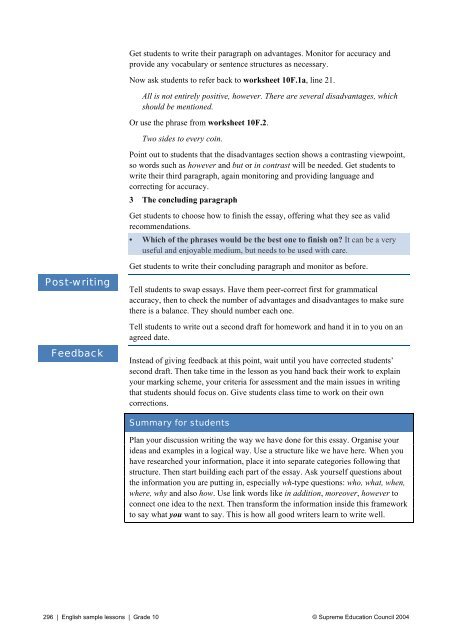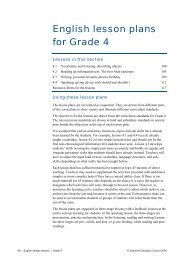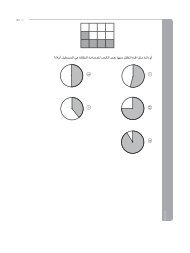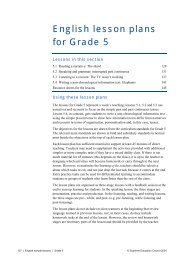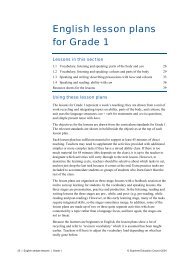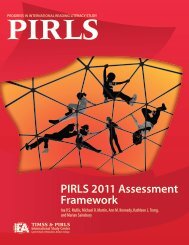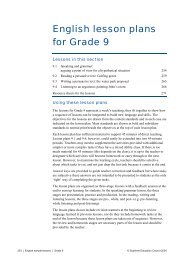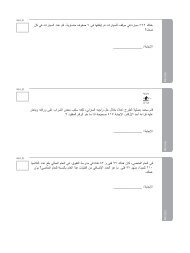English lesson plans for Grade 10
English lesson plans for Grade 10
English lesson plans for Grade 10
Create successful ePaper yourself
Turn your PDF publications into a flip-book with our unique Google optimized e-Paper software.
Get students to write their paragraph on advantages. Monitor <strong>for</strong> accuracy and<br />
provide any vocabulary or sentence structures as necessary.<br />
Now ask students to refer back to worksheet <strong>10</strong>F.1a, line 21.<br />
All is not entirely positive, however. There are several disadvantages, which<br />
should be mentioned.<br />
Or use the phrase from worksheet <strong>10</strong>F.2.<br />
Two sides to every coin.<br />
Point out to students that the disadvantages section shows a contrasting viewpoint,<br />
so words such as however and but or in contrast will be needed. Get students to<br />
write their third paragraph, again monitoring and providing language and<br />
correcting <strong>for</strong> accuracy.<br />
3 The concluding paragraph<br />
Get students to choose how to finish the essay, offering what they see as valid<br />
recommendations.<br />
• Which of the phrases would be the best one to finish on? It can be a very<br />
useful and enjoyable medium, but needs to be used with care.<br />
Post-writing<br />
Feedback<br />
Get students to write their concluding paragraph and monitor as be<strong>for</strong>e.<br />
Tell students to swap essays. Have them peer-correct first <strong>for</strong> grammatical<br />
accuracy, then to check the number of advantages and disadvantages to make sure<br />
there is a balance. They should number each one.<br />
Tell students to write out a second draft <strong>for</strong> homework and hand it in to you on an<br />
agreed date.<br />
Instead of giving feedback at this point, wait until you have corrected students’<br />
second draft. Then take time in the <strong>lesson</strong> as you hand back their work to explain<br />
your marking scheme, your criteria <strong>for</strong> assessment and the main issues in writing<br />
that students should focus on. Give students class time to work on their own<br />
corrections.<br />
Summary <strong>for</strong> students<br />
Plan your discussion writing the way we have done <strong>for</strong> this essay. Organise your<br />
ideas and examples in a logical way. Use a structure like we have here. When you<br />
have researched your in<strong>for</strong>mation, place it into separate categories following that<br />
structure. Then start building each part of the essay. Ask yourself questions about<br />
the in<strong>for</strong>mation you are putting in, especially wh-type questions: who, what, when,<br />
where, why and also how. Use link words like in addition, moreover, however to<br />
connect one idea to the next. Then trans<strong>for</strong>m the in<strong>for</strong>mation inside this framework<br />
to say what you want to say. This is how all good writers learn to write well.<br />
296 | <strong>English</strong> sample <strong>lesson</strong>s | <strong>Grade</strong> <strong>10</strong> © Supreme Education Council 2004


